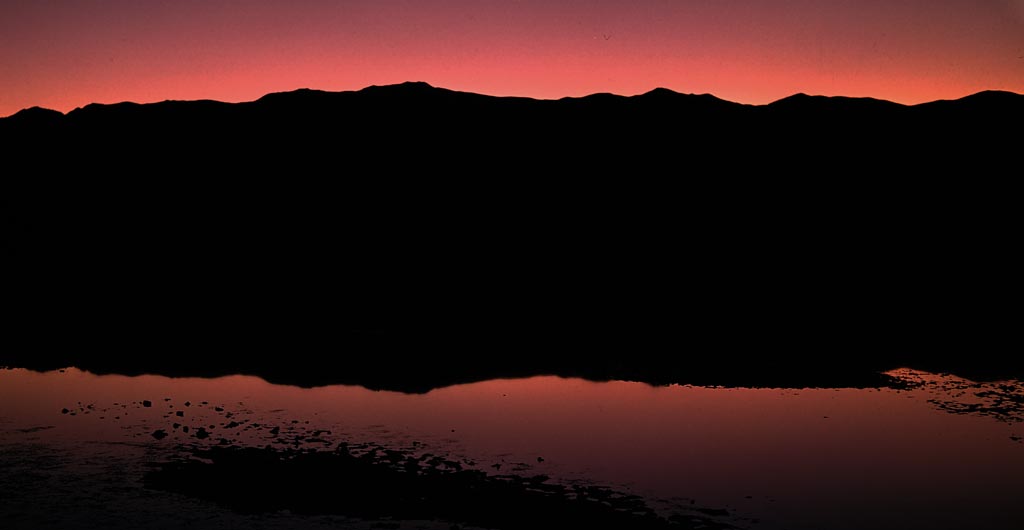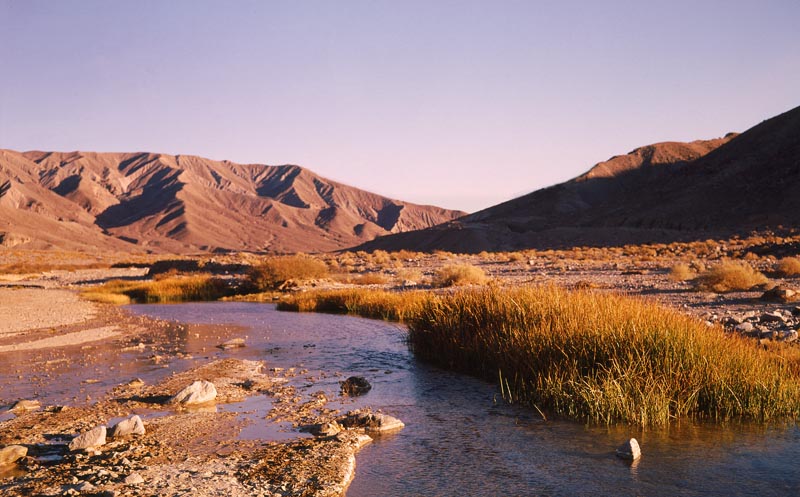The Springs of Death Valley
by
Richard Denning
![]()

The
Springs of Death Valley
by Richard Denning
The warm, moist air moves slowly onto the coast of California after
thousands of miles and many days over the sea. It is loaded with
water, and a steady rain falls on the green hills as it has during
thousands of winters past. And, as before, an obstacle stands in the
storm's path. The Coast Range, a string of mountains from two to four
thousand feet high and four hundred miles long, forces the air higher
and higher, expanding it and cooling it until it is made to give up
more of the precious moisture carried for so long.
Rain
and snow are left behind as the inexorable journey continues across
the central valley to another great barrier, the Sierra Nevada. Once
again the air is raised by the pressure behind and the slopes in
front, is diffused and dessicated, leaving a white mantle on
thousands of square miles of mountain peaks and stocking California's
water supply for another year. Yet the process is unfinished. Before
releasing this storm to the arrid southwest, nature will use yet
another mountain wall to wring it dry, almost to the last drop.
As
the tempest floats at last over the Inyo and Panamint mountains, the
land drops away into a vast valley, one hundred miles long and two
hundred-eighty feet lower than the sea. The air falls and is
compressed, warming itself and the land. This is Death Valley, the
lowest place in the United States and often the hottest spot on
earth.

Death
Valley from Dante's View
This is a very dry valley.
Infrequent rainfall amounting to one and three quarters inches per
year is more than balanced by an evaporation rate estimated at one
hundred fifty inches per year. Because of this, the valley has become
a great salt flat, a remnant of the evaporation of Lake Manly ter to
fifteen thousand years ago, and of ages of mineralized water running
into the sink with no outlet. These deep salt beds are over a
thousand feet thick in places, and have rendered even some relatively
well watered areas barren of life.
The suprising thing,
however, is not that much of the water is salty, but that any water
in the valley could be fresh. Some amazement generally accompanies
the discovery that a chain of springs, wells and ponds reaches from
one end of the valley to the other, in the midst of the salt and
sand, yet quite drinkable.

In
a region so hot and dry, the little water there is assumes a great
importance to the growth and distribution of plant and animal life.
The distribution of water, of course, is controlled by the geologic
formations that trap it, funnel it, and occasionally release it to
the surface. In those few places where moisture does come near the
surface, Death Valley assumes a lush, humid, almost tropical aspect
as hundreds of plant types compete for the rapidly evaporating
fluid.
Animal life, too finds itself controlled in large part
by the geology of Death Valley. All larger animals need water to
drink, and ultimately plants to eat. Even the Kangaroo rat and Pocket
mouse, who meet their requirements by synthesis of water from dry
foods, are concentrated near the plants whose seeds they eat. Many
species of birds live in the valley or migrate there, including a
surprising variety of aquatic types feeding in the marshy areas near
the springs.
Another part of the struggle between life and
geology here is the adaptation that some species have made to the
adverse heat, salt and dryness that really define Death Valley. Salt
Creek, Saratoga Spring, and the Amargosa River, for example, are home
for fish, a unique species for each of these water sources. The
constancy of these springs can be appreciated by realizing that the
last period of wetness in the valley disappeared over two thousand
years ago, yet these fish still live, generations passing by the
hundreds in small water holes.
Even the salty basin
itself is not totally devoid of life. At Badwater, another unique
species, an aquatic snail, lives in water so saline that salt
crystals grow from the banks. Here also is found Ditchgrass growing
in ponds much saltier than the oceans. Fungi and bacteria have been
grown from samples of valley water containing sixteen per cent
dissolved solids, five times the concentration of seawater.
 But
the Death Valley of legend is no haven for plants and animals, nor is
its glory to be found on those cool, often cold days of winter when a
casual visitor may tour the valley in a day. Rather, the real wonder
that is Death Valley must be savored in the heat, the drought, the
full bloom of an afternoon in July. In this season, Man's priorities
are inevitably simplified to those of the other creatures of the
park: shade and water. Then, Man, too is governed by a few geologic
relationships just as surely as any Creosote or Coyote.
But
the Death Valley of legend is no haven for plants and animals, nor is
its glory to be found on those cool, often cold days of winter when a
casual visitor may tour the valley in a day. Rather, the real wonder
that is Death Valley must be savored in the heat, the drought, the
full bloom of an afternoon in July. In this season, Man's priorities
are inevitably simplified to those of the other creatures of the
park: shade and water. Then, Man, too is governed by a few geologic
relationships just as surely as any Creosote or Coyote.
--End-
All rights reserved